turn signal YAMAHA GIGGLE50 2009 Owners Manual
[x] Cancel search | Manufacturer: YAMAHA, Model Year: 2009, Model line: GIGGLE50, Model: YAMAHA GIGGLE50 2009Pages: 74, PDF Size: 0.9 MB
Page 6 of 74
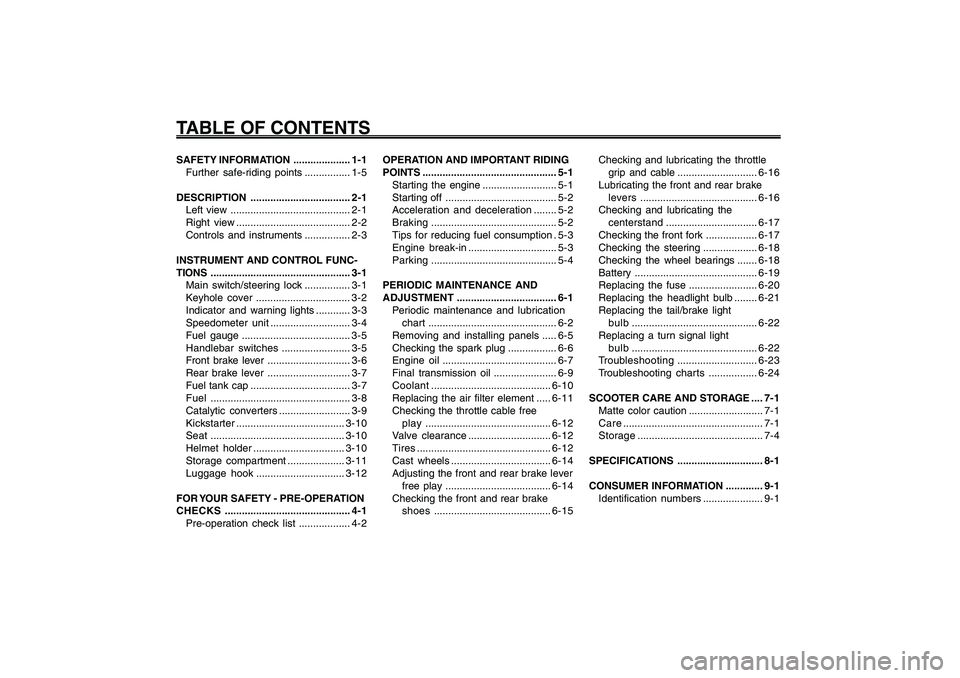
1
2
3
4
5
6
7
8
9
EAU10210
TABLE OF CONTENTSSAFETY INFORMATION .................... 1-1
Further safe-riding points ................ 1-5
DESCRIPTION ................................... 2-1
Left view .......................................... 2-1
Right view ........................................ 2-2
Controls and instruments ................ 2-3
INSTRUMENT AND CONTROL FUNC-
TIONS................................................. 3-1
Main switch/steering lock ................ 3-1
Keyhole cover ................................. 3-2
Indicator and warning lights ............ 3-3
Speedometer unit............................ 3-4
Fuel gauge ...................................... 3-5
Handlebar switches........................ 3-5
Front brake lever ............................. 3-6
Rear brake lever ............................. 3-7
Fuel tank cap ................................... 3-7
Fuel................................................. 3-8
Catalytic converters ......................... 3-9
Kickstarter......................................3-10
Seat...............................................3-10
Helmet holder................................3-10
Storage compartment ....................3-11
Luggage hook...............................3-12
FOR YOUR SAFETY - PRE-OPERATION
CHECKS............................................ 4-1
Pre-operation check list .................. 4-2OPERATION AND IMPORTANT RIDING
POINTS............................................... 5-1
Starting the engine .......................... 5-1
Starting off ....................................... 5-2
Acceleration and deceleration........ 5-2
Braking............................................ 5-2
Tips for reducing fuel consumption . 5-3
Engine break-in............................... 5-3
Parking............................................ 5-4
PERIODIC MAINTENANCE AND
ADJUSTMENT................................... 6-1
Periodic maintenance and lubrication
chart............................................. 6-2
Removing and installing panels ..... 6-5
Checking the spark plug ................. 6-6
Engine oil........................................ 6-7
Final transmission oil ...................... 6-9
Coolant..........................................6-10
Replacing the air filter element .....6-11
Checking the throttle cable free
play............................................6-12
Valve clearance.............................6-12
Tires...............................................6-12
Cast wheels ...................................6-14
Adjusting the front and rear brake lever
free play .....................................6-14
Checking the front and rear brake
shoes.........................................6-15Checking and lubricating the throttle
grip and cable ............................6-16
Lubricating the front and rear brake
levers.........................................6-16
Checking and lubricating the
centerstand................................6-17
Checking the front fork ..................6-17
Checking the steering ...................6-18
Checking the wheel bearings .......6-18
Battery ...........................................6-19
Replacing the fuse ........................6-20
Replacing the headlight bulb ........6-21
Replacing the tail/brake light
bulb............................................6-22
Replacing a turn signal light
bulb............................................6-22
Troubleshooting............................6-23
Troubleshooting charts.................6-24
SCOOTER CARE AND STORAGE .... 7-1
Matte color caution .......................... 7-1
Care................................................. 7-1
Storage............................................ 7-4
SPECIFICATIONS.............................. 8-1
CONSUMER INFORMATION ............. 9-1
Identification numbers..................... 9-1
Page 9 of 74
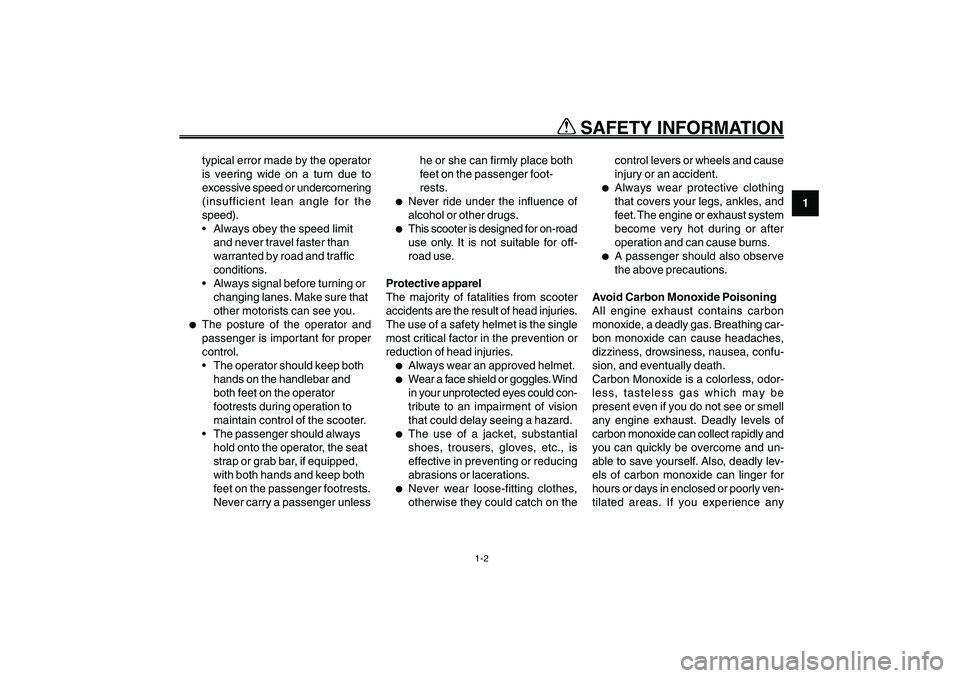
1-9
EAU10221
Q QQ Q
Q
SAFETY INFORMATION
1
2
3
4
5
6
7
8
9
1-2
typical error made by the operator
is veering wide on a turn due to
excessive speed or undercornering
(insufficient lean angle for the
speed).
Always obey the speed limit
and never travel faster than
warranted by road and traffic
conditions.
Always signal before turning or
changing lanes. Make sure that
other motorists can see you.
●
The posture of the operator and
passenger is important for proper
control.
The operator should keep both
hands on the handlebar and
both feet on the operator
footrests during operation to
maintain control of the scooter.
The passenger should always
hold onto the operator, the seat
strap or grab bar, if equipped,
with both hands and keep both
feet on the passenger footrests.
Never carry a passenger unlesshe or she can firmly place both
feet on the passenger foot-
rests.
●
Never ride under the influence of
alcohol or other drugs.
●
This scooter is designed for on-road
use only. It is not suitable for off-
road use.
Protective apparel
The majority of fatalities from scooter
accidents are the result of head injuries.
The use of a safety helmet is the single
most critical factor in the prevention or
reduction of head injuries.
●
Always wear an approved helmet.
●
Wear a face shield or goggles. Wind
in your unprotected eyes could con-
tribute to an impairment of vision
that could delay seeing a hazard.
●
The use of a jacket, substantial
shoes, trousers, gloves, etc., is
effective in preventing or reducing
abrasions or lacerations.
●
Never wear loose-fitting clothes,
otherwise they could catch on thecontrol levers or wheels and cause
injury or an accident.
●
Always wear protective clothing
that covers your legs, ankles, and
feet. The engine or exhaust system
become very hot during or after
operation and can cause burns.
●
A passenger should also observe
the above precautions.
Avoid Carbon Monoxide Poisoning
All engine exhaust contains carbon
monoxide, a deadly gas. Breathing car-
bon monoxide can cause headaches,
dizziness, drowsiness, nausea, confu-
sion, and eventually death.
Carbon Monoxide is a colorless, odor-
less, tasteless gas which may be
present even if you do not see or smell
any engine exhaust. Deadly levels of
carbon monoxide can collect rapidly and
you can quickly be overcome and un-
able to save yourself. Also, deadly lev-
els of carbon monoxide can linger for
hours or days in enclosed or poorly ven-
tilated areas. If you experience any
Page 12 of 74
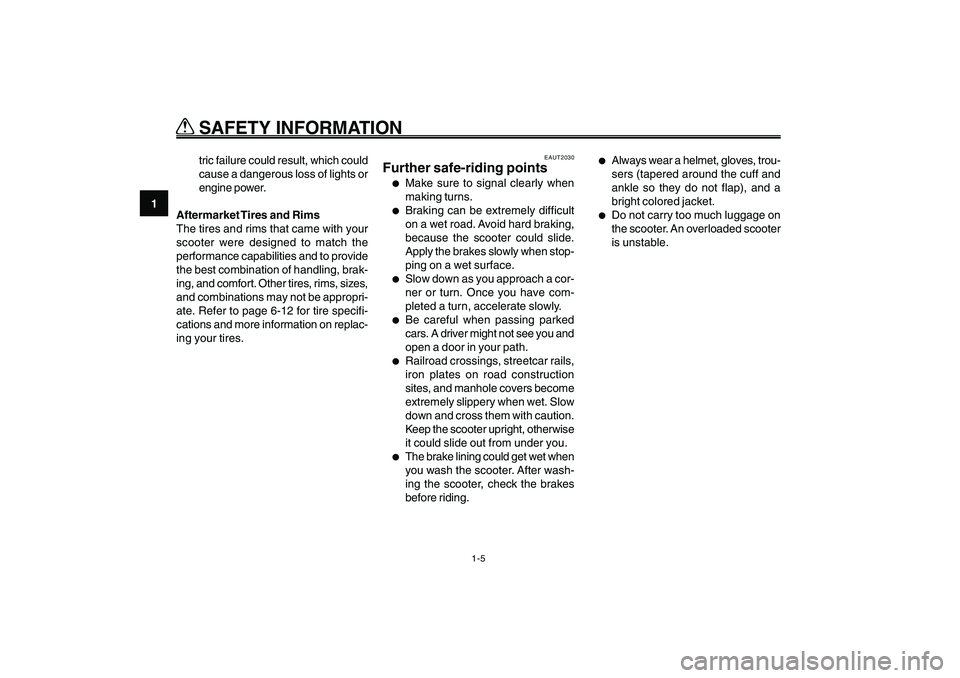
1-12
EAU10221
Q QQ Q
Q
SAFETY INFORMATION
1
2
3
4
5
6
7
8
9
EAUT2030
Further safe-riding points●
Make sure to signal clearly when
making turns.
●
Braking can be extremely difficult
on a wet road. Avoid hard braking,
because the scooter could slide.
Apply the brakes slowly when stop-
ping on a wet surface.
●
Slow down as you approach a cor-
ner or turn. Once you have com-
pleted a turn, accelerate slowly.
●
Be careful when passing parked
cars. A driver might not see you and
open a door in your path.
●
Railroad crossings, streetcar rails,
iron plates on road construction
sites, and manhole covers become
extremely slippery when wet. Slow
down and cross them with caution.
Keep the scooter upright, otherwise
it could slide out from under you.
●
The brake lining could get wet when
you wash the scooter. After wash-
ing the scooter, check the brakes
before riding.
●
Always wear a helmet, gloves, trou-
sers (tapered around the cuff and
ankle so they do not flap), and a
bright colored jacket.
●
Do not carry too much luggage on
the scooter. An overloaded scooter
is unstable.
1-5
Safe-riding points
tric failure could result, which could
cause a dangerous loss of lights or
engine power.
Aftermarket Tires and Rims
The tires and rims that came with your
scooter were designed to match the
performance capabilities and to provide
the best combination of handling, brak-
ing, and comfort. Other tires, rims, sizes,
and combinations may not be appropri-
ate. Refer to page 6-12 for tire specifi-
cations and more information on replac-
ing your tires.
Page 14 of 74

2-14
1
2
3
4
5
6
7
8
9
EAU10401
DESCRIPTION
EAU10401
DESCRIPTION
2-1
EAU10410
Left view1. Front turn signal light (page 6-22)
2. Fuel tank cap (page 3-7)
3. Luggage hook (page 3-12)
4. Helmet holder (page 3-10)
5. Battery (page 6-19)
6. Storage compartment (page 3-11)
7. Air filter (page 6-11)
8. Rear turn signal light (page 6-22)Part locations
1
23, 4, 56
8
7
Page 19 of 74
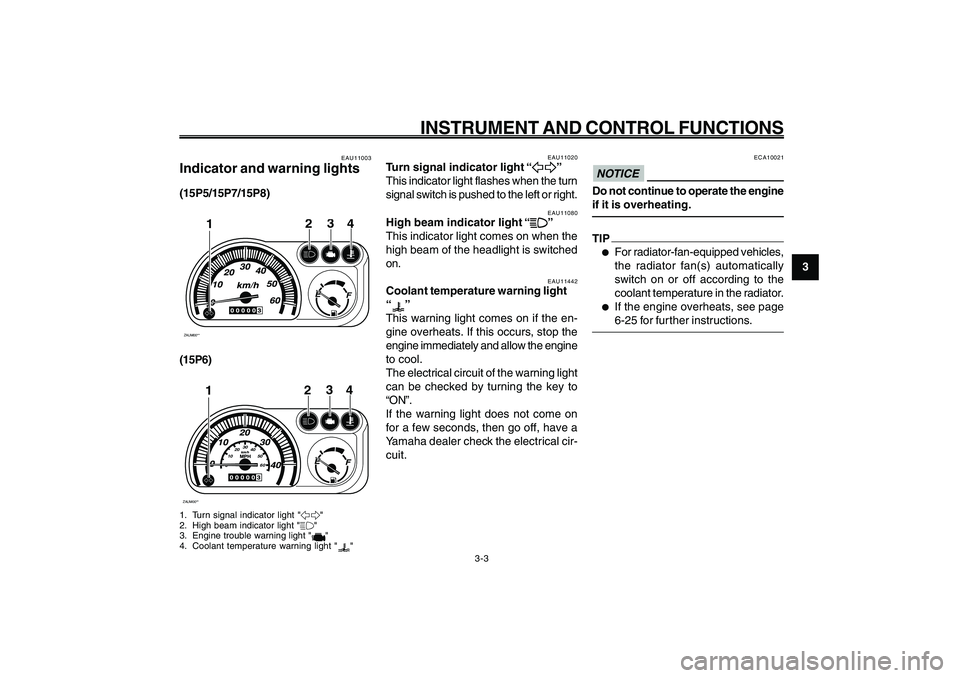
3-19
1
2
3
4
5
6
7
8
9
EAU1044E
INSTRUMENT AND CONTROL FUNCTIONS
EAU11020
Turn signal indicator light “
5 55 5
5”
This indicator light flashes when the turn
signal switch is pushed to the left or right.
EAU11080
High beam indicator light “
& && &
&”
This indicator light comes on when the
high beam of the headlight is switched
on. Indicator and warning lights
Turn signal indicator light
High beam indicator light
Coolant temperature warning light
EAU11442
Coolant temperature warning light
“
”
This warning light comes on if the en-
gine overheats. If this occurs, stop the
engine immediately and allow the engine
to cool.
The electrical circuit of the warning light
can be checked by turning the key to
“ON”.
If the warning light does not come on
for a few seconds, then go off, have a
Yamaha dealer check the electrical cir-
cuit.
3-3
EAU11003
Indicator and warning lights(15P5/15P7/15P8)ZAUM00**
3
24
1
(15P6)ZAUM00**
0102030
40
50
60
3
24
1
1. Turn signal indicator light "5"
2. High beam indicator light "&"
3. Engine trouble warning light "
"
4. Coolant temperature warning light "
"
ECA10021
NOTICEDo not continue to operate the engine
if it is overheating.TIP●
For radiator-fan-equipped vehicles,
the radiator fan(s) automatically
switch on or off according to the
coolant temperature in the radiator.
●
If the engine overheats, see page
6-25 for further instructions.
Page 21 of 74
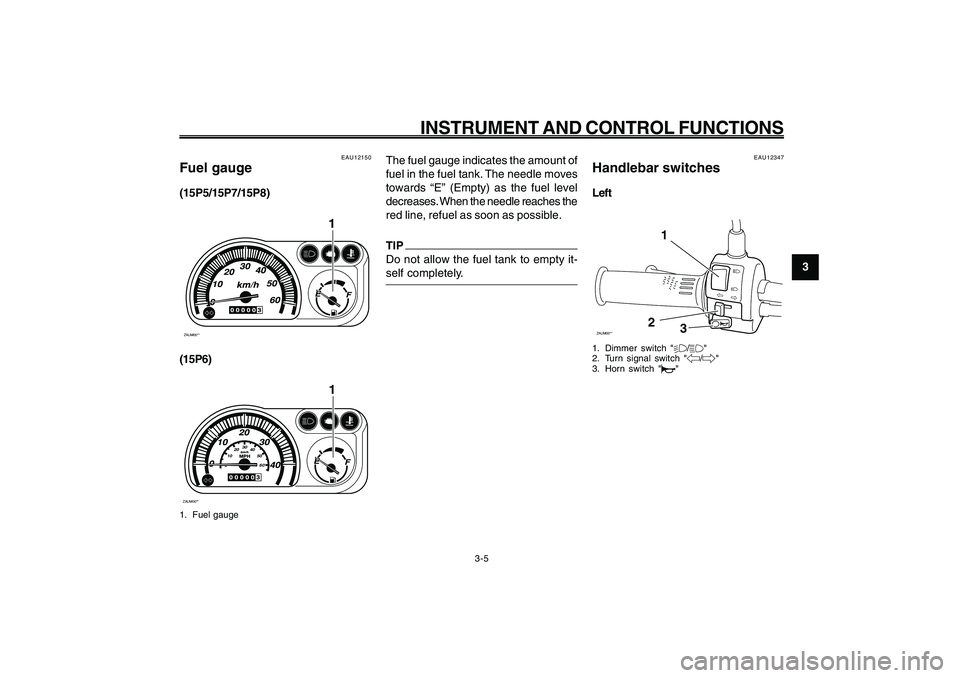
3-21
1
2
3
4
5
6
7
8
9
EAU1044E
INSTRUMENT AND CONTROL FUNCTIONS
3-5
The fuel gauge indicates the amount of
fuel in the fuel tank. The needle moves
towards “E” (Empty) as the fuel level
decreases. When the needle reaches the
red line, refuel as soon as possible.TIP
Do not allow the fuel tank to empty it-
self completely.
EAU12347
Handlebar switchesLeftZAUM00**
1
2
3
1. Dimmer switch "%/&"
2. Turn signal switch "4/6"
3. Horn switch "*"
Fuel gauge
Handlebar switches
EAU12150
Fuel gauge(15P5/15P7/15P8)ZAUM00**
1
(15P6)ZAUM00**
1
0102030
40
50
60
1. Fuel gauge
Page 22 of 74
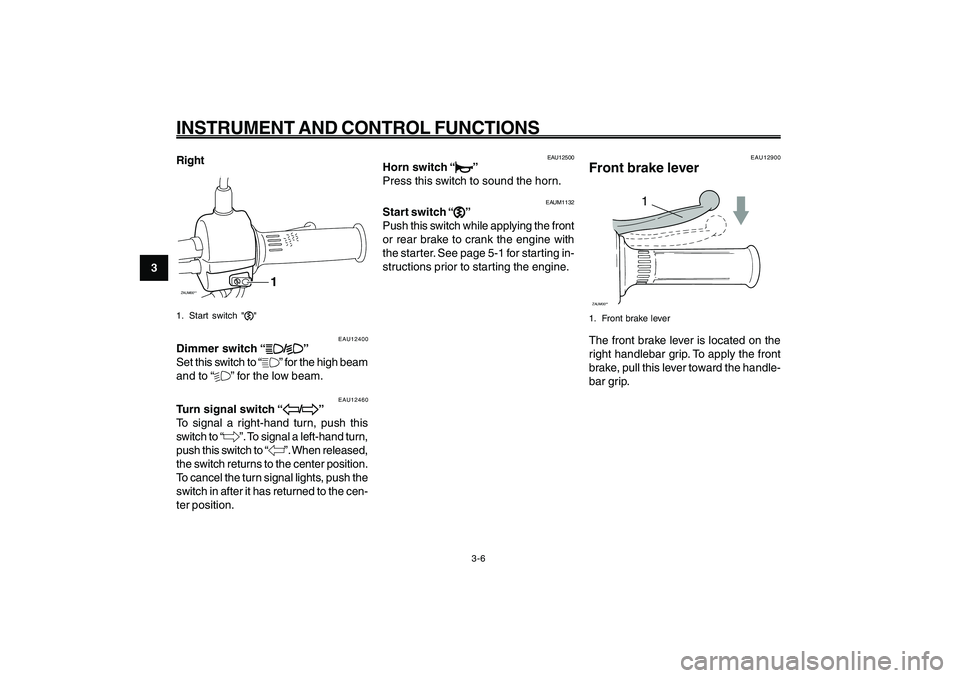
3-22
1
2
3
4
5
6
7
8
9
EAU1044E
INSTRUMENT AND CONTROL FUNCTIONSDimmer switch
Turn signal switch
Horn switch
Start switch
Brake lever, front
EAU12460
Turn signal switch “
4 44 4
4/
6 66 6
6”
To signal a right-hand turn, push this
switch to “6”. To signal a left-hand turn,
push this switch to “4”. When released,
the switch returns to the center position.
To cancel the turn signal lights, push the
switch in after it has returned to the cen-
ter position.
EAU12500
Horn switch “
* ** *
*”
Press this switch to sound the horn.
EAU12400
Dimmer switch “
& && &
&/
% %% %
%”
Set this switch to “&” for the high beam
and to “%” for the low beam.
EAUM1132
Start switch “
, ,, ,
,”
Push this switch while applying the front
or rear brake to crank the engine with
the starter. See page 5-1 for starting in-
structions prior to starting the engine.
3-6
EAU12900
Front brake lever
1
ZAUM00**1. Front brake leverThe front brake lever is located on the
right handlebar grip. To apply the front
brake, pull this lever toward the handle-
bar grip. Right
ZAUM00**
1
1. Start switch ","
Page 33 of 74
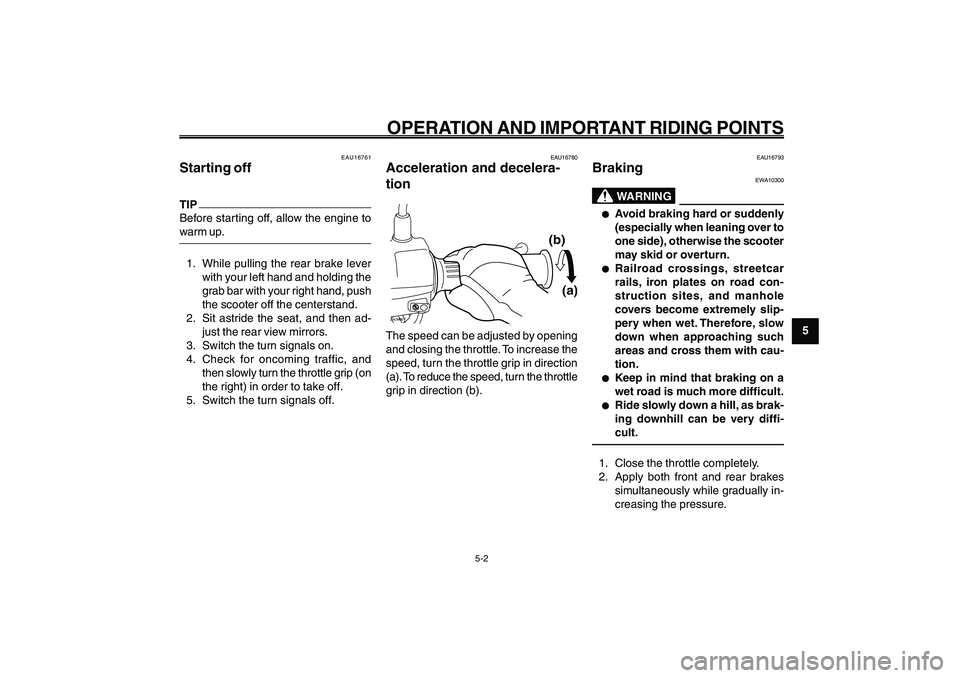
5-33
1
2
3
4
5
6
7
8
9
EAU15943
OPERATION AND IMPORTANT RIDING POINTS
5-2
Starting off
Acceleration and deceleration
Braking
EAU16780
Acceleration and decelera-
tionZAUM00**
(a) (b)
The speed can be adjusted by opening
and closing the throttle. To increase the
speed, turn the throttle grip in direction
(a). To reduce the speed, turn the throttle
grip in direction (b).
EAU16793
Braking
EWA10300
WARNING
● ●● ●
●
Avoid braking hard or suddenly
(especially when leaning over to
one side), otherwise the scooter
may skid or overturn.
● ●● ●
●
Railroad crossings, streetcar
rails, iron plates on road con-
struction sites, and manhole
covers become extremely slip-
pery when wet. Therefore, slow
down when approaching such
areas and cross them with cau-
tion.
● ●● ●
●
Keep in mind that braking on a
wet road is much more difficult.
● ●● ●
●
Ride slowly down a hill, as brak-
ing downhill can be very diffi-
cult.
1. Close the throttle completely.
2. Apply both front and rear brakes
simultaneously while gradually in-
creasing the pressure.
EAU16761
Starting offTIP
Before starting off, allow the engine to
warm up.1. While pulling the rear brake lever
with your left hand and holding the
grab bar with your right hand, push
the scooter off the centerstand.
2. Sit astride the seat, and then ad-
just the rear view mirrors.
3. Switch the turn signals on.
4. Check for oncoming traffic, and
then slowly turn the throttle grip (on
the right) in order to take off.
5. Switch the turn signals off.
Page 57 of 74
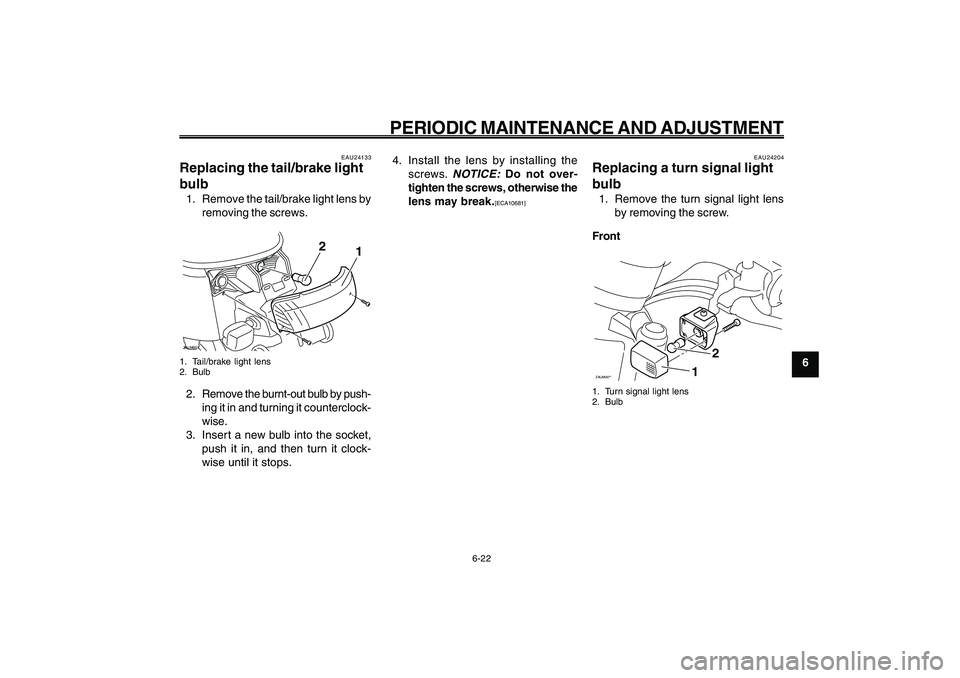
6-57
1
2
3
4
5
6
7
8
9
EAU1722A
PERIODIC MAINTENANCE AND ADJUSTMENT
6-22
Tail/brake light bulb, replacing
Turn signal light bulb, replacing
EAU24204
Replacing a turn signal light
bulb1. Remove the turn signal light lens
by removing the screw.
FrontZAUM00**
2
1
1. Turn signal light lens
2. Bulb
EAU24133
Replacing the tail/brake light
bulb1. Remove the tail/brake light lens by
removing the screws.ZAUM00**
1
2
1. Tail/brake light lens
2. Bulb2. Remove the burnt-out bulb by push-
ing it in and turning it counterclock-
wise.
3. Insert a new bulb into the socket,
push it in, and then turn it clock-
wise until it stops.4. Install the lens by installing the
screws.
NOTICE:
Do not over-
tighten the screws, otherwise the
lens may break.[ECA10681]
Page 58 of 74
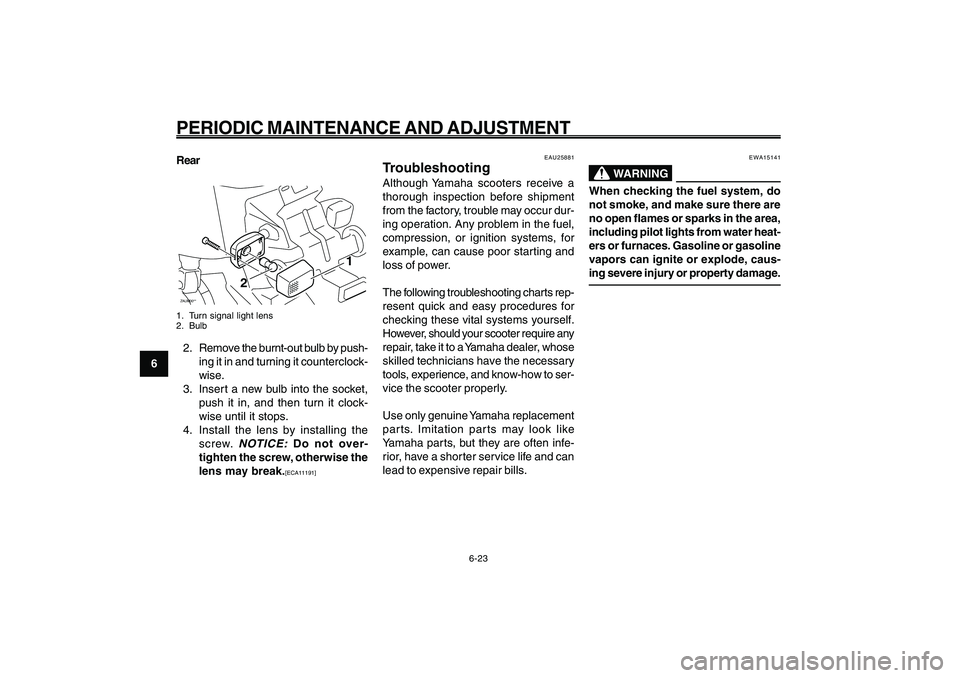
6-58
1
2
3
4
5
6
7
8
9
EAU1722A
PERIODIC MAINTENANCE AND ADJUSTMENT
6-23
EWA15141
WARNING
When checking the fuel system, do
not smoke, and make sure there are
no open flames or sparks in the area,
including pilot lights from water heat-
ers or furnaces. Gasoline or gasoline
vapors can ignite or explode, caus-
ing severe injury or property damage.
EAU25881
TroubleshootingAlthough Yamaha scooters receive a
thorough inspection before shipment
from the factory, trouble may occur dur-
ing operation. Any problem in the fuel,
compression, or ignition systems, for
example, can cause poor starting and
loss of power.
The following troubleshooting charts rep-
resent quick and easy procedures for
checking these vital systems yourself.
However, should your scooter require any
repair, take it to a Yamaha dealer, whose
skilled technicians have the necessary
tools, experience, and know-how to ser-
vice the scooter properly.
Use only genuine Yamaha replacement
parts. Imitation par ts may look like
Yamaha parts, but they are often infe-
rior, have a shorter service life and can
lead to expensive repair bills. Troubleshooting
Rear
ZAUM00**
1
2
1. Turn signal light lens
2. Bulb2. Remove the burnt-out bulb by push-
ing it in and turning it counterclock-
wise.
3. Insert a new bulb into the socket,
push it in, and then turn it clock-
wise until it stops.
4. Install the lens by installing the
screw.
NOTICE:
Do not over-
tighten the screw, otherwise the
lens may break.[ECA11191]